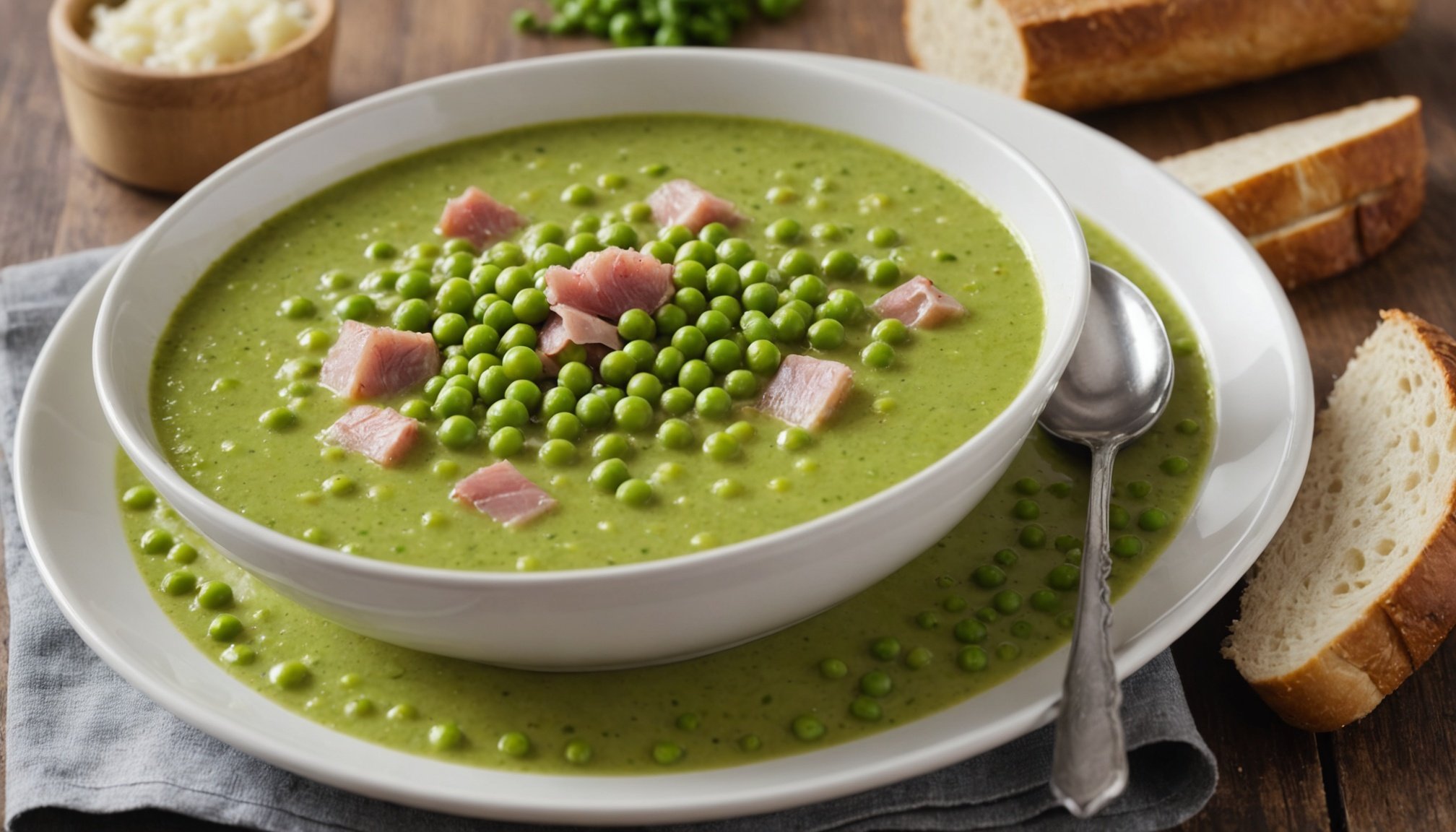Overview of Classic English Pea & Ham Soup
Classic English Pea and Ham Soup holds a cherished spot in culinary traditions. This hearty dish reflects a blend of historical recipe roots and adaptable evolutions over time. Its origins can be traced back to ancient Roman times, yet it has been refined through centuries to become a staple in English cuisine.
Historically, pea and ham soup was considered a thrifty and nourishing meal, popular among both the wealthy and the working class. The dish offered a clever use of leftover ham, making it an economical choice for many households. Its appeal extends beyond just its practicality; the culinary traditions surrounding this dish emphasize comfort and simplicity, resonating with a wide audience.
This might interest you : Master the Art of Crafting a Perfect Golden Crust Beef and Onion Pie: A Classic Recipe Revealed
Over the years, the classic recipe has evolved, reflecting changes in ingredients and cooking styles. The availability of fresh produce and improved cooking techniques have allowed this soup to be enriched with vibrant flavors. Despite its transformation, the essence of pea and ham soup remains rooted in its ability to provide warmth and nourishment.
In exploring pea and ham soup’s journey, the combination of tradition and adaptation is evident, celebrating both heritage and contemporary tastes. Its historical charm and versatile nature ensure its continued presence in kitchens worldwide.
Also read : Master the Art of Spotted Dick: An Exquisite Recipe with Decadent Custard, Step-by-Step
Ingredients List
A well-prepared Pea and Ham Soup starts with selecting the right ingredients. Using quality ingredients ensures the best flavors and texture in your dish. For a classic recipe, the essentials include dried or fresh peas, a ham hock or bone, and an assortment of vegetables like onions, carrots, and celery. These fresh produce items contribute a depth of flavor, enhancing the soup’s wholesome nature.
The importance of choosing quality ingredients cannot be overstated. Fresh peas, whether dried or frozen, bring natural sweetness and creamy texture to the soup. Opting for a meaty, smoked ham hock introduces a savory richness that balances the dish. Whenever possible, use organic vegetables, as they tend to offer more robust flavors, producing a superior result.
In catering to specific dietary needs, substitutions or alternatives can be incorporated without sacrificing taste. For instance, using smoked turkey instead of ham can appease non-pork eaters. Additionally, exploring vegan adaptations is feasible, where smoked paprika or liquid smoke provides a similar flavor profile sans meat. Ensuring each ingredient is of high quality not only impacts taste but turns a simple soup into a delightful culinary experience.
Step-by-Step Cooking Instructions
Embarking on the adventure of making Classic English Pea and Ham Soup is rewarding and enjoyable. Following a structured step-by-step guide ensures a delightful culinary experience.
Preparation of Ingredients
Start with preparing your quality ingredients. Chop onions, carrots, and fresh produce such as celery into even pieces to guarantee even cooking. If using dried peas, soak them overnight for a softer texture and enhanced absorption during cooking. For a smoked ham hock, clean it thoroughly to remove any impurities.
Cooking Techniques
The cooking process begins by sautéing the vegetables in a large pot until they become translucent, releasing flavours. Add the ham hock and drained peas to the pot, ensuring they are evenly distributed. Pour in enough water or broth to cover, bringing it to a gentle boil. Lower the heat, allowing it to simmer slowly for about 90 minutes. This length of cooking softens the peas and extracts flavour from the ham.
Final Touches
Finally, remove the ham hock, shredding the meat to be added back into the soup. Adjust seasoning with salt and pepper to taste. For a creamier texture, partially blend the soup using a hand blender. Enjoy the soup preparation process and savour the satisfying results.
Cooking Tips and Tricks
Enhancing the flavour profile of Classic English Pea and Ham Soup can be achieved with several cooking tips. First, consider incorporating freshly cracked pepper and a sprinkle of herbs such as thyme or parsley towards the end of cooking. These additions accentuate the earthy and savoury tones of the soup. Meal prep suggestions include preparing and soaking the peas overnight, which significantly reduces cooking time and improves texture.
If the soup turns out too thin, a common issue, simply puree a portion and mix it back in, thickening it naturally without sacrificing flavour. For those seeking deeper savoury notes, a dash of Worcestershire sauce can introduce additional umami.
Enhancing flavor is pivotal for an outstanding dish, so do not shy away from tasting and adjusting, particularly in terms of salt. Be mindful, however, that ham hocks can be salty; it’s best to season incrementally to avoid overpowering the dish.
For easy storage and reheating, divide the soup into portion-sized containers, ensuring it cools to room temperature beforehand. With these tips, crafting a delightful and satisfying pea and ham soup becomes an achievable and enjoyable culinary adventure.
Variations of the Recipe
Exploring different recipe variations can add exciting new dimensions to the classic English Pea and Ham Soup. For those seeking creative twists, substituting the traditional ham with proteins like smoked chicken or turkey can create a unique flavour profile while retaining the soup’s comforting essence. Dietary adaptations allow everyone to enjoy this beloved dish, with popular choices including vegetarian versions using plant-based sausages or smoked tofu.
To make a vegan version, consider incorporating ingredients like smoked paprika or liquid smoke for that signature smokiness, paired with vegetable broth instead of traditional meat-based options. Adding hearty vegetables such as potatoes or turnips enhances the texture and nutritional content for those seeking an even more filling meal.
Cultural variations also exist, where diverse influences introduce further flair. For example, Scandinavian versions often incorporate mustard or dill for a tangy twist, while Mediterranean adaptations may add herbs like rosemary or basil. Embracing these variations allows for personalisation and creativity, encouraging cooks to experiment while appreciating the versatile nature of pea and ham soup. With minor adjustments, this classic dish can transform to suit various culinary preferences and dietary needs.
Nutritional Information
Classic English Pea and Ham Soup is not only a culinary delight but also a nutritious option for those mindful of their dietary intake. The nutritional facts of this soup highlight its ability to provide substantial sustenance, making it a healthy addition to your meal plan.
This soup typically offers a balance of proteins, fats, and essential vitamins. The peas contribute to a high fiber content, aiding digestion and promoting a feeling of fullness. Peas are also a source of protein and vitamins like K and C. On the other hand, ham adds valuable proteins and healthy fats necessary for bodily functions. However, be cautious of the sodium content, especially when using smoked or cured ham, to avoid excessive intake.
To make the recipe healthier, consider opting for low-sodium broth and leaner cuts of ham. Substituting traditional ham with smoked turkey or using plant-based proteins for a vegan alternative can adjust the nutritional profile to suit specific dietary needs. Including extra vegetables like spinach or kale not only enhances the vitamin count but also adds depth to the texture and flavour. This way, the pea and ham soup remains a nutritionally balanced and delicious choice.
User Reviews and Experiences
User feedback for Classic English Pea and Ham Soup generally highlights its comforting nature and versatility. Many home cooks appreciate its rich history and the way it evokes memories of traditional meals. A common praise is the robust, hearty flavour achieved through the balance of ham and peas. However, some users have noted that adapting the recipe for dietary needs can sometimes be challenging, but it’s rewarding when done right.
The cooking experiences shared tend to emphasise the enjoyable process of preparing this dish. Some users recount nostalgic stories of learning the recipe from family members, illustrating the soup’s place in personal culinary traditions. These anecdotes often describe how slight tweaks to the historical recipe—like adding unexpected herbs or substituting ingredients—result in delightful surprises.
Community insights encourage budding chefs to explore these creative adjustments, assuring that adherence to basic techniques yields satisfying results. Many users recommend engaging with online forums and social media groups dedicated to this dish, which offer support and inspiration. Ultimately, sharing one’s journey with Classic English Pea and Ham Soup adds a layer of community and collaboration to the culinary adventure.
Serving Suggestions
Enhancing the dining experience with Classic English Pea and Ham Soup involves thoughtful presentation and pairing. Creating a visually appealing table setting not only elevates the meal but also captures the essence of this traditional dish. Consider using rustic bowls to complement the soup’s hearty nature, and garnish with freshly chopped parsley for a pop of color.
Pairing Ideas
Accompaniments are vital in turning a comforting soup into a robust meal. Pairing the soup with a crusty artisan bread or a warm, buttery roll can enhance its rustic appeal while soaking up the rich flavors. A light, mixed green salad, perhaps with a tangy vinaigrette, provides a refreshing contrast to the soup’s savory depth. Embrace seasonal produce by adding roasted root vegetables as a supplementary dish, providing complementary textures and flavors.
Beverage Pairings
When selecting a beverage, aim for options that will complement the soup’s savory profile. Light, crisp beers or white wines such as Sauvignon Blanc offer a refreshing palate cleanser. Opt for a non-alcoholic choice by serving sparkling water with a slice of lemon or lime, maintaining a sense of sophistication without alcohol. With thoughtful pairings, a simple soup can become an elegant dining experience.



